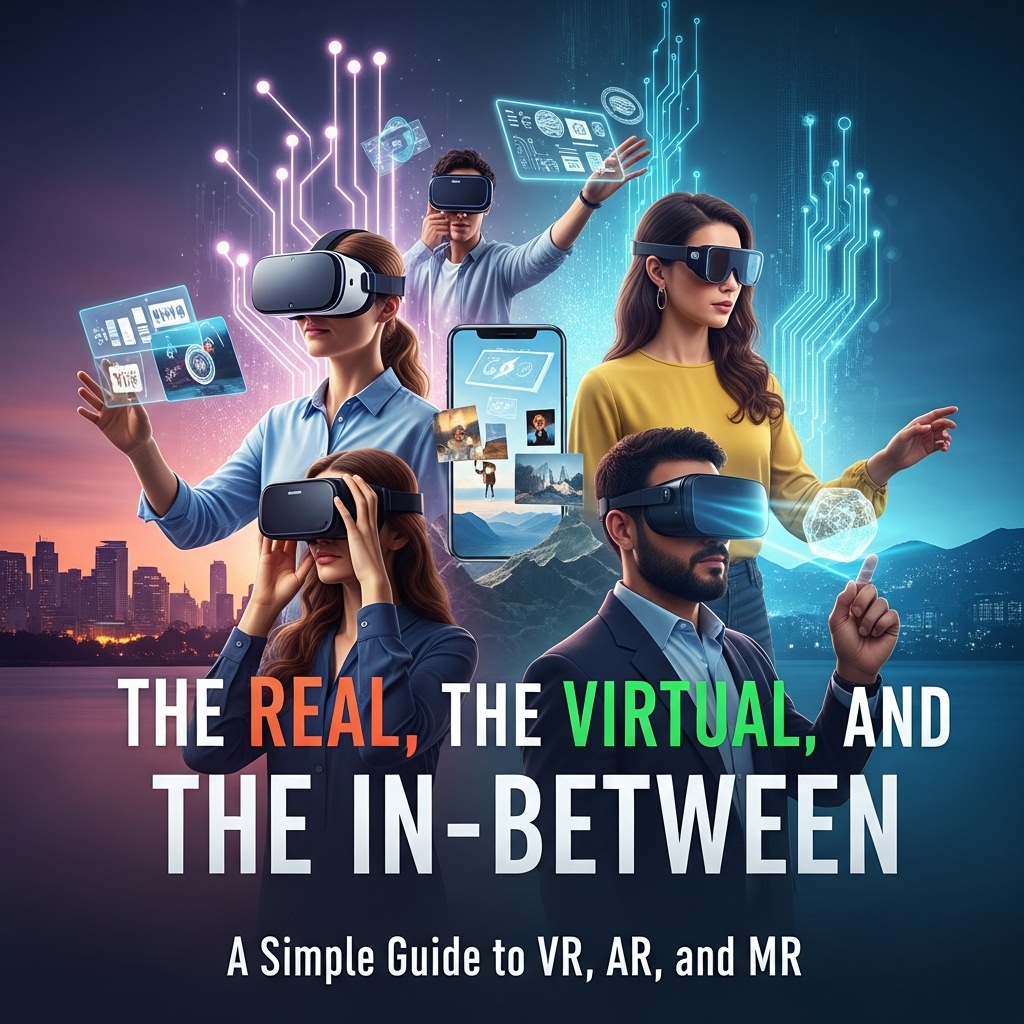Introduction: Navigating the Reality Spectrum
The contemporary technological landscape is saturated with terms that promise to redefine our interaction with the digital world: Virtual Reality (VR), Augmented Reality (AR), and Mixed Reality (MR). These acronyms are frequently used interchangeably, creating confusion that obscures their fundamental differences. This guide will establish a definitive, first-principles-based framework for understanding this landscape, deconstructing each concept under the unifying paradigm of Spatial Computing.
To accurately classify these technologies, we use the Reality-Virtuality Continuum. The continuum is a spectrum with two poles: at one end is the Real Environment (our unfiltered physical reality), and at the other is the Virtual Environment (a completely computer-generated world). The space between is Mixed Reality, and AR and VR are specific points along this spectrum.
Pillar I: Virtual Reality (VR) – The Principle of Total Immersion
First Principles of VR
Virtual Reality is defined by its foundational goal: the complete replacement of a user’s sensory input from the physical world with a computer-generated, artificial environment. The primary objective is to trick the user’s brain into accepting the digital simulation as real, inducing a powerful psychological state known as “presence“—the distinct sensation of “being there” inside the virtual space.
VR in Action – Beat Saber
The popular rhythm game Beat Saber is a quintessential example of pure VR:
- Environmental Replacement: From the moment a player puts on the headset, their physical room disappears. They are transported to a stylized, “futuristic world.”
- Sensory Immersion: 360-degree visuals, spatial audio, and haptic feedback in the controllers combine to convince the user’s brain that they are an active participant.
- Interaction Model: The player’s physical hands are mapped to virtual sabers that interact exclusively with virtual objects.
Pillar II: Augmented Reality (AR) – The Principle of Information Overlay
First Principles of AR
Augmented Reality is defined by its core function: to superimpose or overlay digital information—such as graphics, text, or sound—onto a user’s view of the real world. Unlike VR, AR does not replace the user’s environment. A critical characteristic of traditional AR is that the digital overlay and the physical world are generally not aware of each other.
AR in Action – Pokémon GO
The global phenomenon Pokémon GO is the most widely recognized example of AR:
- Overlay, Not Integration: The game uses a smartphone’s camera to display a live video feed, and a virtual Pokémon is rendered on top.
- Lack of Environmental Awareness: The Pokémon does not stand on a real-world table or hide behind a physical chair. It is effectively a digital sticker placed over a live video.
AR’s key attribute is its accessibility, delivered through devices people already own and accelerated by software like Apple’s ARKit and Google’s ARCore.
Pillar III: Mixed Reality (MR) – The Principle of Integration and Interaction
First Principles of MR
Mixed Reality represents a significant evolution from AR. It is defined by the principle that digital objects are not merely overlaid upon the real world but are integrated into it. The foundational characteristic of MR is that virtual objects and the physical environment are mutually aware and can interact with each other in real-time. This is made possible by:
- Environmental Understanding: The MR device creates a dynamic, 3D digital map of the physical space.
- Anchoring: The ability to “pin” a digital object to a specific coordinate in the real world.
- Occlusion: The ability for real-world objects to block the view of a virtual object behind it.
The leap from AR to MR is the machine’s capacity for real-time environmental awareness, using a sophisticated suite of sensors like cameras, depth sensors, and LiDAR.
MR in Action – The Apple Vision Pro Experience
The Apple Vision Pro is a state-of-the-art exemplar of Mixed Reality. A user can open a virtual web browser and place its window in their living room. This window becomes spatially anchored. If the user walks behind their real-life sofa, the physical sofa will occlude their view of the virtual window, demonstrating the principle of integration.
| Feature | Virtual Reality (VR) | Augmented Reality (AR) | Mixed Reality (MR) |
|---|---|---|---|
| Core Principle | Replacement | Overlay | Integration |
| User’s Worldview | Fully synthetic | Real world, enhanced by digital info | Real world with interactive digital content |
| Digital/Physical Interaction | None | Limited to none | High |
| Exemplar Device | Meta Quest 3 | Smartphones (ARKit/ARCore) | Apple Vision Pro, Microsoft HoloLens 2 |
The Unifying Paradigm: Spatial Computing
While VR, AR, and MR describe specific experiences, they all fall under a broader paradigm shift: Spatial Computing. This term refers to any interaction where a machine retains and manipulates referents to real objects and spaces, liberating computation from 2D screens and integrating it into the 3D physical world.
The deliberate industry pivot to champion “Spatial Computing” is a significant strategic maneuver. By marketing the Vision Pro as the first “spatial computer” and forbidding developers from using terms like AR, VR, or MR, Apple is attempting to redefine the entire category. This is a classic platform strategy aimed at shifting perception away from niche applications and toward the concept of a new, universal computing platform.
Conclusion: A Unified and Evolving Landscape
The landscape of immersive technologies can be understood through a clear taxonomy. VR achieves Replacement, AR provides an Overlay, and MR enables Integration. These are different implementations within the unifying paradigm of Spatial Computing—a shift that is weaving digital interaction into our three-dimensional world.
Looking forward, the lines between these categories will continue to blur. A single device will be able to seamlessly shift from a simple AR overlay to an integrated MR workspace, and then to a fully immersive VR environment. The principles of Spatial Computing will evolve from a niche concept into an integral component of how we learn, work, communicate, and experience the world.

